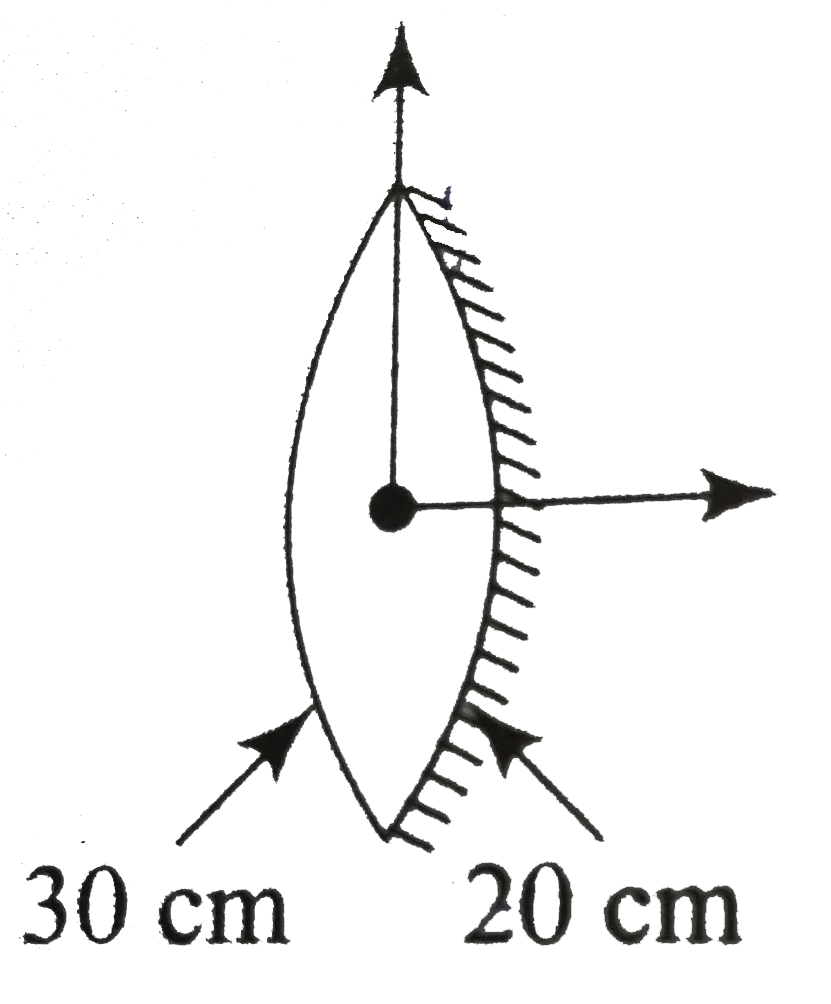Two plano-concave lenses of glass of refractive 1.5 have radii of curvature of 20 and 30 cm. They are placed in contact with curved surface towards each other and the space between yhem is filled with a liquid of refractive index 2/3. Find the focal length of the system.
To find the focal length of the system consisting of two plano-concave lenses and a liquid in between, we will follow these steps:
Step 1: Understand the Configuration
The system consists of two plano-concave lenses placed in contact with their curved surfaces facing each other. The space between them is filled with a liquid of refractive index 23. The refractive index of the glass lenses is 1.5.
Step 2: Identify the Radii of Curvature
- For Lens 1 (left lens):
- Radius of curvature R1=+∞ (since it is plano)
- Radius of curvature R2=−20 cm (concave surface)
- For Lens 2 (right lens):
- Radius of curvature R1=−30 cm (concave surface)
- Radius of curvature R2=+∞ (since it is plano)
Step 3: Calculate the Focal Length of Each Lens Using the Lens Maker's Formula
The lens maker's formula is given by:
1f=(n−1)(1R1−1R2)
Focal Length of Lens 1 (f1):
1f1=(1.5−1)(1∞−1−20)
1f1=0.5(0+120)=0.5⋅120=140
Thus, f1=−40 cm.
Focal Length of Lens 2 (f2):
1f2=(1.5−1)(1−30−1∞)
1f2=0.5(−130−0)=−0.530=−160
Thus, f2=−60 cm.
Step 4: Calculate the Focal Length of the Liquid Lens (f3)
For the liquid lens, we have:
1f3=(23−1)(120−1−30)
1f3=−13(120+130)
Finding a common denominator for 120+130:
120=360,130=260⇒120+130=560=112
Thus,
1f3=−13⋅112=−136
So, f3=+36 cm.
Step 5: Combine the Focal Lengths
Using the formula for the combination of lenses:
1f=1f1+1f2+1f3
Substituting the values:
1f=−140−160+136
Finding a common denominator (LCM of 40, 60, and 36 is 360):
1f=−9360−6360+10360=−5360
Thus,
f=−72 cm
Final Answer
The focal length of the system is −72 cm.
---
The system consists of two plano-concave lenses placed in contact with their curved surfaces facing each other. The space between them is filled with a liquid of refractive index 23. The refractive index of the glass lenses is 1.5.
- For Lens 1 (left lens):
- Radius of curvature R1=+∞ (since it is plano)
- Radius of curvature R2=−20 cm (concave surface)
- For Lens 2 (right lens):
- Radius of curvature R1=−30 cm (concave surface)
- Radius of curvature R2=+∞ (since it is plano)
The lens maker's formula is given by:
1f=(n−1)(1R1−1R2)
1f1=(1.5−1)(1∞−1−20)
1f1=0.5(0+120)=0.5⋅120=140
Thus, f1=−40 cm.
1f2=(1.5−1)(1−30−1∞)
1f2=0.5(−130−0)=−0.530=−160
Thus, f2=−60 cm.
For the liquid lens, we have:
1f3=(23−1)(120−1−30)
1f3=−13(120+130)
120=360,130=260⇒120+130=560=112
Thus,
1f3=−13⋅112=−136
So, f3=+36 cm.
Using the formula for the combination of lenses:
1f=1f1+1f2+1f3
Substituting the values:
1f=−140−160+136
1f=−9360−6360+10360=−5360
Thus,
f=−72 cm
The focal length of the system is −72 cm.
Topper's Solved these Questions
- BOOK - DC PANDEY ENGLISHCHAPTER - RAY OPTICSEXERCISE - Checkpoint 9.110videos
RAY OPTICS
- BOOK - DC PANDEY ENGLISHCHAPTER - RAY OPTICSEXERCISE - Checkpoint 9.210videos
RAY OPTICS
- BOOK - DC PANDEY ENGLISHCHAPTER - NUCLEIEXERCISE - C MADICAL ENTRANCES GALLERY46videos
NUCLEI
- BOOK - DC PANDEY ENGLISHCHAPTER - REFLECTION OF LIGHTEXERCISE - Subjective9videos
REFLECTION OF LIGHT
Similar Questions
Two plano-concave lenses of glass of refractive index 1.5 have radii of curvature of 20 and 30 cm. They are placed in contact with curved surface towards each other and the space between them is filled with a liquid of refractive index 43, find the focal length of the system.
View SolutionTwo plano concave lenses of glass of refractive index 1.5 have radii of curvature 20 cm and 30 cm respectively. They are placed in contact with the curved surface towards each other and the space between them is filled with a liquid of refractive index 5/2. The focal length of the combination is (in cm)
View SolutionTwo identical thin planoconvex glass lenses (refractive index 1.5) each having radius of curvature of 20cm are placed with their convex surfaces in contact at the centre. The intervening space is filled with oil of refractive index 1.7. The focal length of the combination is
View SolutionTwo identical thin planoconvex glass lenses (refractive index 1.5) each having radius of curvature of 20 cm are placed with their convex sufaces in contact at the centre. The intervening space is filled with oil of refractive index 1.7 The focal length of the combination is
View SolutionTwo concave lenses L1andL2 are kept in contact with each other. If the space between the two lenses is filled with a material of smaller refractive index, the magnitude of the focal length of the combination
View SolutionA plano-concave lens is made of glass of refractive index 1.5 and the radius of curvature of its curved face is 100 cm. What is the power of the lens?
View SolutionA plano convex lens is made of glass of refractive index 1.5. The radius of curvature of its convex surface is R. Its focal length is
View SolutionA concavo-convex lens has refractive index 1.5 and the radii of curvature of its surfaces are 10cmand20cm. The concave surface is upwords and is filled with oil of refractive index 1.6. The focal length of the combination will be
View SolutionA concavo-convex lens is made of glass of refractive index 1.5. The radii of curvature of its two surfaces are 30cm and 50cm. Its focal length when placed in a liquid of refractive index 1.4 is
View SolutionA biconvex lens is made of glass with refractive index 1.5 and has radii of curvature 20 cm and 30 cm. If the 20 cm surface is silvered, what is the effective focal length of the mirror formed?
 View Solution
View Solution

